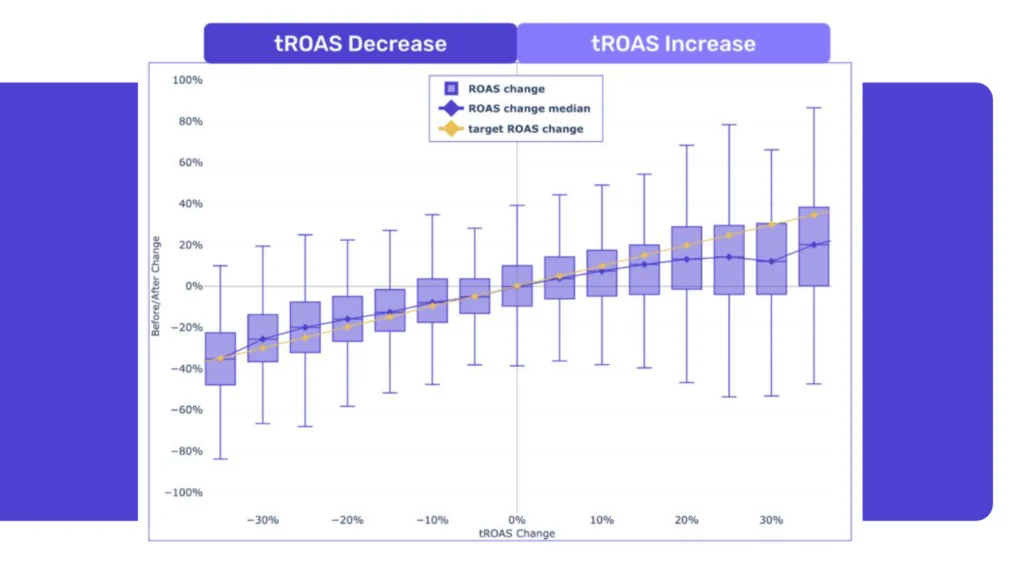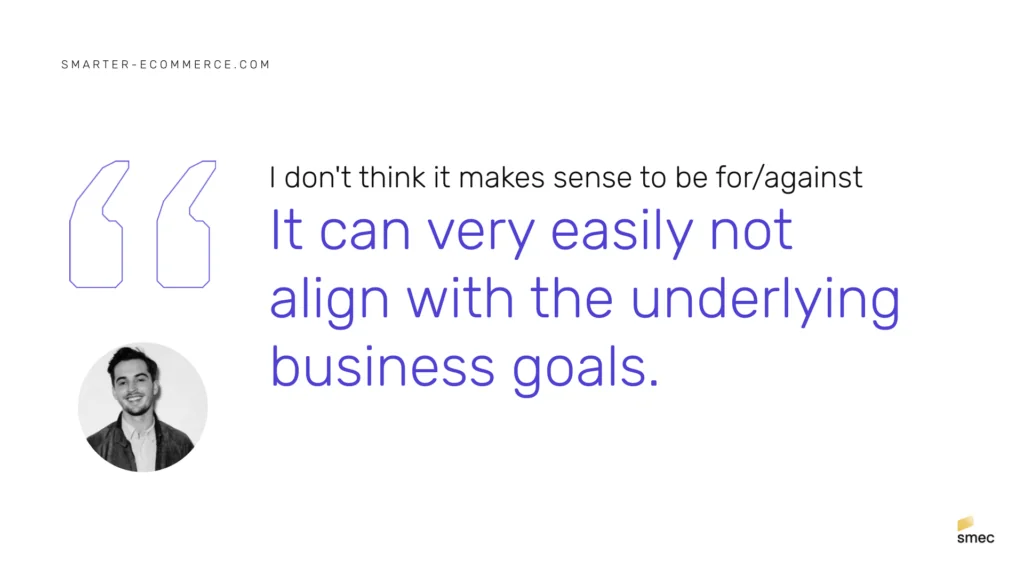Subscribe to join thousands of other ecommerce experts

When it comes to Performance Max (PMax) campaigns, there’s always a lot more ground to cover. During my Q&A marathon after our most recent webinar – Performance Max Decoded – I ran out of time to answer all the burning PMax questions you had on your minds. Which is a shame, since you brought up a lot of interesting stuff – from PMax seasonality adjustments, to brand exclusions and your critical first-party data.
Lucky for you, I’ve collected the 18 hottest questions and will answer them for you in detail here!
This is a sequel, if you will, to our Hot PMax questions: best campaign setup, reporting, incrementality & more blog. So make sure to give that one a read if there are any more open PMax questions for you after reading this. We’ve updated it recently, so chances are you’ll get your answers!
Without further ado, let’s dive in:
Table of Contents
PMax seasonality adjustments, optimizations & more
What do you think of agencies that set up PMax campaigns and rarely manage them? Shouldn’t there be regular optimizations?
When Google first started selling PMax, we had one rep who said you can turn on PMax and just go on vacation for the rest of the month. That’s not quite true as it turns out.
Every time I host a webinar about PMax, I reliably get about 30 questions. I now have a spreadsheet with over 120 questions in it, and this is my third time writing a PMax Q&A article. Not my idea of vacation lol.
So, yes: there should be regular optimization in your PMax campaigns. Ideas include but are not limited to:
- Campaign setup:
Campaign structure, asset group structure, bid strategy, budget - Assets & ad content:
Images, videos, extensions - Audience strategy:
audience signals, locations, exclusions, NCA strategies - Destinations:
URL expansion, page feeds - Competition:
Price benchmarks, auction insights - Tracking & measurement:
Conversion tracking, conversion value, split testing, MMM/lift studies - And more …
Hope that answers your question. (*cough* call us *cough*)
Do changes to tROAS vs PMax seasonality adjustments work together or against each other?
They don’t necessarily confuse the algorithm, but they should serve different purposes.
Your target ROAS is a core steering component of your campaign (arguably business goal). It should remain rather stable, changing not more often than every 14 days. Your PMax seasonality adjustments are highly flexible and designed for periods of a week or less, max 14 days.
So you’ve got a short-term measure and a mid-term measure. If you happen to change them at the same time I wouldn’t sweat it, but if you’re purposely changing them at the same time I think it’s worth questioning.

What best practices should I follow for making seasonality adjustments in PMax?
Generally speaking, when we conduct seasonality adjustments, we make sure to:
- Analyze Historical Data: Review past performance data to identify trends and peak periods.
- Set Adjustment Periods: Use this data to set specific time frames for adjustments, such as Black Friday or the holiday season.
- Adjust Bids and Budgets: Increase bids and budgets during peak periods to capture more traffic and decrease them during slow periods to save on ad spend.
- Monitor and Refine: Continuously monitor performance and refine adjustments based on real-time data.
Do you optimize the asset signals?
I think you meant to write “audience signals” (which are attached to the asset group). This is an interesting idea that I don’t personally have experience with, but I’ll dare to comment:
Audience signals are hard to optimize. They are start signals and Google will learn from them and expand on them in ways that we cannot know or control. You can update audience signals with fresh data, but this again acts as another start signal, effectively a new cohort – and Google will learn and expand on it. The previous “cohort” and its expansions remain.
The challenge of 1P audiences is the 1P part. For the sake of argument, let’s imagine you upload a list of brand-loyal customers. Google doesn’t know that they are brand-loyal. It will learn other things about them, which may or may not correlate to loyalty, and then expand on that, which may or may not find more of who you’re looking for.
Does brand exclusion improve my return on ad spend (ROAS) in PMax?
It absolutely can. By excluding brand terms and URLs where your site already performs well organically, you can focus your ad spend on more competitive, high-converting non-brand terms.
This can improve your ROAS by ensuring your budget is spent on acquiring new customers rather than paying for existing brand traffic.
Is there any script you recommend for tracking traffic split by network?
Yes, I’d recommend Mike Rhodes’ Pmax Insights Script (no affiliation). It’s based on research by Tobias Hink and it works by reverse calculating and estimating more detailed placement reporting than what Google offers. There are both free and paid versions available.
You might also be interested in our free PMax Brand Traffic Analyzer, which shows the volume and performance of brand traffic over time. Plus we have channel insights and other exclusive insights built into our platform.
(Un)common use cases
Is PMax suitable for companies of all sizes? It doesn’t seem to meet the needs of large enterprises.
Yes and no.
On the one hand, the high level of automation benefits SMBs, which might not have the knowledge or resources to manage more complex campaign types. On the other hand, PMax is incredibly thirsty for data and budget – so in that way enterprises have an advantage.
Either way, PMax can look great in the platform – tons of revenue, great efficiency – and still not be working as hard as it could. Common problems include a dependence on brand traffic, remarketing, and bestsellers. As Performance Max seeks to maximize performance (like its name suggests) it can actually be a bit “lazy” by pursuing sure bets, rather than focusing on what’s important to your business.
So it definitely works for enterprise – we’ve proven that with clients like THG – but not necessarily out-of-the-box.

For a DTC brand with 1-2 million euros in performance spend per year, what is the better option? PMax or Standard Shopping?
Great question. The fact is, Standard Shopping still works. And while Google likes to portray the switch to PMax as completely seamless and a guaranteed home run, it’s actually a serious decision for any business.
Here are few thoughts to consider:
- Are there Shopping-exclusive features that are crucial for you?
- Conversely, are there PMax-exclusive features that could be big for you?
- Are you already using Smart Bidding?
- Do you have assets in place to take advantage of PMax?
- How granular is your current build and do you have a path to consolidation?
- Do you have other campaign types to consider? (e.g. brand search, display, etc)
Ultimately if you feel you’ve hit a ceiling with Standard Shopping, PMax may be able to offer some additional raw performance power in exchange for some transparency and control.
We can help you make the call – just reach out.
See how we take back control of
Performance Max campaigns
Learn more Getting the most out of PMax
Any tactics for decreasing the share of search in PMax?
You can limit PMax’s ability to serve Search by doing any/all of the following:
- building a feed-only campaign (no assets)
- turning off URL expansion
- opting out of Automatically Created Assets.
Note that these tactics can also limit other kinds of placements besides just Search.
How many different campaigns with varying ROAS steps would you recommend?
We typically see 2 to 7, and most commonly 3, but there are exceptions too. There’s no hard and fast rule.
It will depend on:
- the size and complexity of your catalog
- the amount of monthly conversions
- and of course also your budget
We talked in the webinar about taking care when splitting conversions, but also remember that campaigns need to have sufficient budget.
By the way, budget is also a lever: In principle you could even have two or more campaigns with identical ROAS targets – or even no ROAS target – but notably different budgets. So it’s important to consider the interplay of both your target and your budget.
You don’t *have* to make it rocket science, but we did. This is an area into which we’ve invested considerable research, and for which we have AI/ML that supports us.
How can large corporations manage assets effectively in the browser UI? It seems challenging to achieve a positive ROI.
To be honest, I don’t think you’re missing anything here – it is a pain.
Considering that Google wants advertisers to use assets, they are pushing this through ad strength scores etc, my assumption (and hope) is that they will work on improving this. My only concern is that right now they seem more focused on generative AI tools and automatically created assets, rather than supporting workflows that use conventional assets. I think it’s a case of Shiny Object Syndrome.
On the bright side, at Google Marketing Live 2024, they announced that asset-level reporting is on the way, and that they are offering more brand control on AI-generated assets, for what it’s worth.
How do you use custom first-party data to promote products important to your business?
To be clear, by first-party data, I’m thinking more broadly than 1P audiences. I mean anything that you and only you know about your products, brands, categories, etc.
That could be, for example, your stock depth, your sell-through rate, your margins, your fulfilment, your order openers, your launches, your loss leaders, or any number of first-party attributes. Google simply doesn’t know about this off-channel data, so it *can’t* optimize based on it. It will optimize purely based on the channel data.
You can change this situation by scoring your inventory based on your first-party data, and ensuring they are always in the correct campaign, which is a combination of budget and efficiency target.
What’s also important is that products can end up in the same campaign for different reasons: for example one product might get pushed because it’s a high-margin and behind sales plan, while another product might get pushed because it’s a tool for grabbing market share. You can still have a relatively consolidated campaign structure, yet pursue a complex blend of goals.
We have software that helps you with that.

Advanced strategies
If you move a product from one campaign to another, will it retain its performance history from the previous campaign?
That’s right, product history is matched to the Item ID so, for example, switching between campaigns doesn’t change that history but assigning a new item ID would wipe it clean.
Our approach views campaigns as temporary vehicles rather than permanent homes, and that’s fine for the product history. However, it’s worth noting you don’t want an excessive amount of volatility in your product movement.
A product should not be constantly jumping back and forth between campaigns – I call this “flickering.” If this occurs then there needs to be calibration. The sweet spot is when products are evaluated daily, but only moved when there is a meaningful reason why.
Does the BCG Matrix method work for companies with large data sets?
Poor dogs and stars, heroes and zombies, leaders and bleeders – there are many names for this approach, and yes, it can be a starting point for large data sets. In fact, many data sets are probably too small to use it effectively!
A limitation of this approach is that it can be deceptively challenging to determine how products should be categorized, since most products lack data. You end up splitting hairs to decide what goes in what quadrant, and there’s no statistical significance.
So yes it works, but as a starting point – I wouldn’t stop there. The beauty of being at a company with large data sets is that… you work at a company with large data sets! You can bring in off-channel data that PMax doesn’t already know about and that has a much greater potential to impact the business.
A four-box model like the BCG Matrix is two-dimensional, but you can evaluate your products along multiple dimensions.
Your next steps
That was a rollercoaster ride, wasn’t it?
If the all-powerful Google algorithm brought you here, then we’d highly recommend you watch the full webinar for a deeper dive into Performance Max’s inner workings and how to turn the most common challenges into your strategic success story!
Watch on-demand: Performance Max Decoded: Turning challenges into strategic wins
And as I wrote above: If there are any more questions you want answered, make sure to check out Hot PMax questions: best campaign setup, reporting, incrementality & more.
Or just contact us and we’ll figure it out for you!
We are a bunch of pretty smart pumpkins who can help you get the Performance Max setup that aligns with YOUR business goals, and NOT Google’s.

